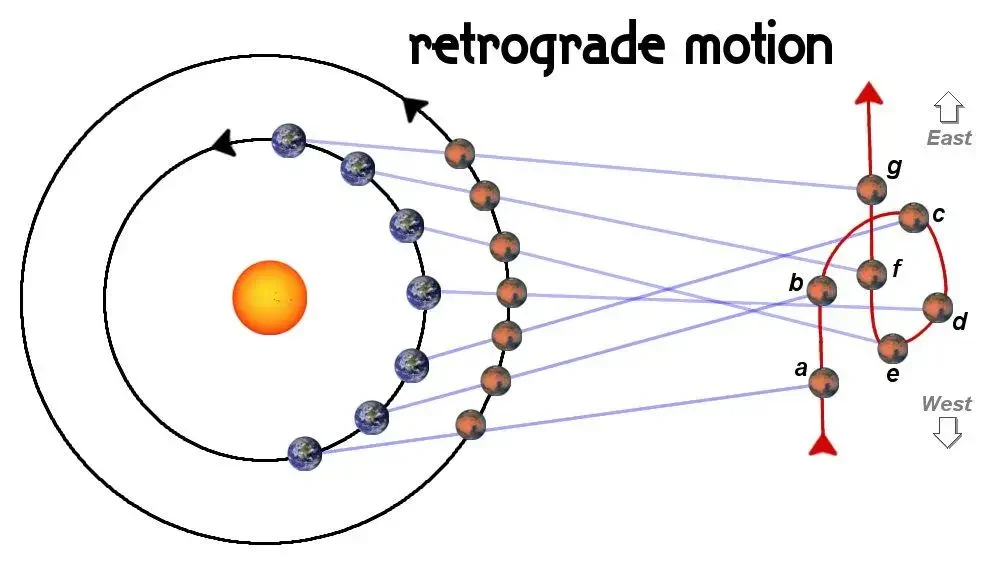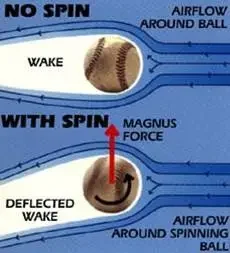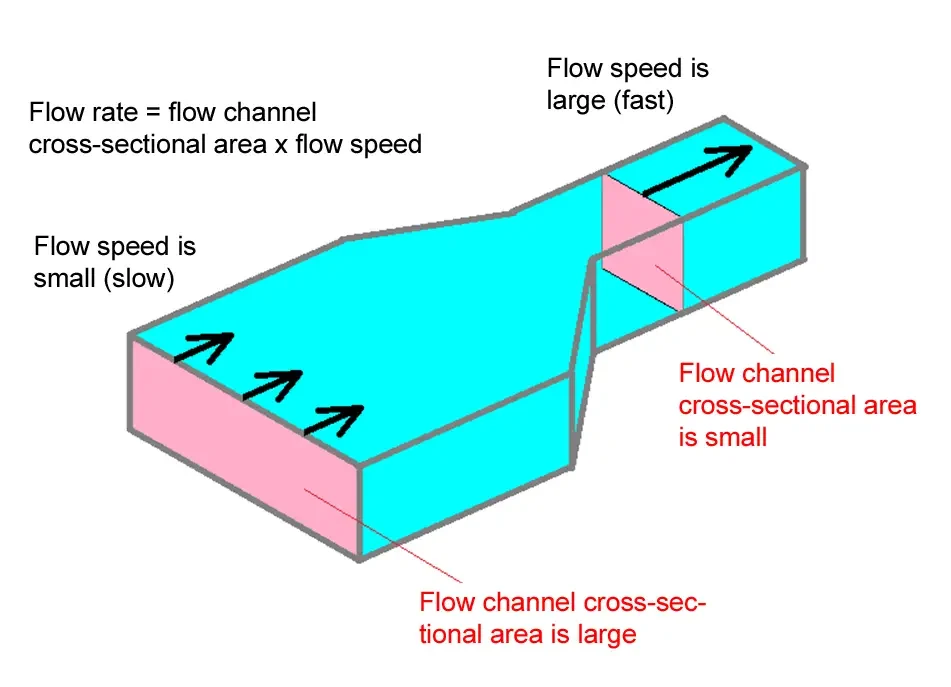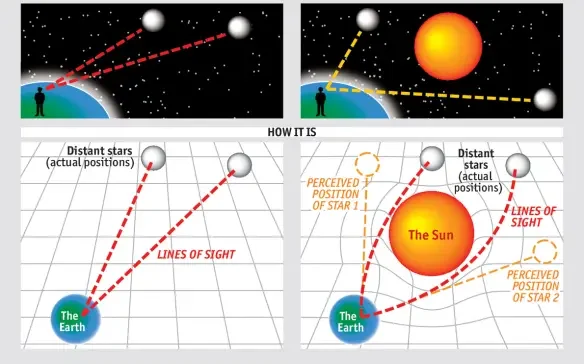Section 1
Kepler’s Second Law:
Kepler’s Second Law, also known as the Law of Equal Areas, states that a line connecting a planet to the Sun sweeps out equal areas in equal intervals of time . This means a planet moves fastest at perihelion (closest to the Sun) and slowest at aphelion (farthest from the Sun) . The law demonstrates conservation of angular momentum in orbital mechanics, revealing how planetary velocity varies to maintain constant areal velocity .

Mars Retrograde Motion: An Illusion from Earth’s Perspective:
Mars retrograde motion is an apparent backward movement of Mars in the sky, observed from Earth as our planet overtakes Mars in their orbits around the Sun. This occurs because Earth, with its shorter orbital period (365 days), moves faster than Mars (687-day orbit), creating a positional illusion where Mars seems to reverse direction against the distant stars. The phenomenon repeats every 780 days (synodic period) and was historically resolved by the heliocentric model, which confirmed that planets orbit the Sun rather than Earth.
Inertial frames of reference:
In inertial frames of reference, objects obey Newton’s first law: they remain at rest or in uniform motion unless acted upon by a force . In this animation, a ball bouncing with horizontal motion appears to follow a zig-zag path when viewed from a stationary frame (e.g., a camera on the ground). However, from the ball’s own inertial frame (which moves with constant velocity relative to the ground), the ball only moves vertically, while the ground and camera appear to move horizontally beneath it . This illustrates the relativity of motion: the description of motion depends on the observer’s frame, but physical laws remain consistent across all inertial frames .
Understanding Spring Force Distribution: Single, Series, and Parallel Arrangements:
Springs obey Hooke’s Law (F=kΔxF=kΔx), where force is proportional to extension . In series configurations, springs experience the same force throughout, resulting in a softer equivalent spring (1/keq=1/k1+1/k21/keq=1/k1+1/k2). In parallel configurations, the load is shared between springs, creating a stiffer system (keq=k1+k2keq=k1+k2) . These principles determine how springs distribute forces in physical systems, influencing their effective stiffness and extension under load

The Magnus Effect: Why Spinning Balls Curve:
The Magnus Effect is a physical phenomenon where a spinning object, like a soccer ball, experiences a sideways force perpendicular to both its direction of motion and spin axis . As the ball spins, it drags surrounding air molecules, creating a pressure difference between opposite sides—higher pressure on one side and lower pressure on the other . This pressure difference generates a net force (called the Magnus force) that causes the ball’s trajectory to curve significantly . The effect is mathematically described by the equation F=S(ω×v), where the force depends on the spin vector and velocity . Understanding this principle is crucial in sports like soccer or physics applications involving fluid dynamics .
How Drinking Straws Really Work: The Power of Atmospheric Pressure:
When you drink from a straw, your lungs expand, reducing air pressure inside the straw . Higher atmospheric pressure on the liquid’s surface outside the straw then pushes the liquid upward to equalize this pressure difference . This demonstrates that liquid flow is driven by atmospheric pressure rather than a “sucking force” . The maximum height liquid can rise is limited by atmospheric pressure (about 10.3 meters for water) . Thus, straws operate on fundamental pressure principles, not vacuum suction.

River Flow Dynamics: Why Narrow Sections Flow Faster:
In fluid dynamics, the conservation of mass dictates that water flow rate remains constant in a river . When the river narrows, the cross-sectional area decreases, forcing water to accelerate to maintain the same discharge . This is visualized by dashed lines representing flow paths: dots move slower in wider sections and faster in narrow sections. The animation demonstrates how velocity inversely correlates with channel width, a key concept in hydraulics and environmental science . Understanding this principle helps explain natural phenomena like erosion patterns and flood behavior

Eddington’s 1919 Eclipse Experiment: Proving Einstein’s Theory:
This animation illustrates the historic 1919 experiment where Arthur Eddington measured the apparent shift of starlight during a solar eclipse. The deflection occurred because the Sun’s mass curves spacetime, bending light rays from distant stars. Eddington’s team compared eclipse photographs with reference night-sky images, revealing a measurable outward shift in star positions. The observed shift matched Einstein’s prediction of 1.75 arcseconds, confirming general relativity and revolutionizing our understanding of gravity. This experiment provided the first direct evidence that gravity bends light.
Why Bicycle Pumps Get Hot: The Physics of Compression Work:
When you compress air rapidly in a bicycle pump, the work done on the gas increases its internal energy, as described by the first law of thermodynamics (ΔU=Q−WΔU=Q−W) . This adiabatic process leaves no time for heat exchange with the surroundings, so the work input directly converts to thermal energy . Microscopically, molecules gain kinetic energy and collide more frequently, raising the temperature . The pump’s piston and cylinder heat up as a result of this energy transfer, illustrating how mechanical work becomes thermal energy .
Why Steam Burns Are More Severe Than Boiling Water Burns:
Steam at 100°C causes more severe burns than boiling water at the same temperature because it releases significantly more energy upon contact with skin. When steam condenses, it first releases a large amount of latent heat of vaporization (2257 J/g), which is the energy stored during its phase change from water to vapor. This is followed by the sensible heat released as the condensed water cools to skin temperature (≈264 J/g). In contrast, boiling water only releases sensible heat (≈264 J/g). Steam transfers about 9.5 times more total energy than boiling water, causing deeper and more severe tissue damage through rapid heat penetration and moisture-assisted energy transfer .
Sound Diffraction: Why Sound Bends Around Corners:
Sound diffraction is the bending and spreading of sound waves as they encounter obstacles or pass through openings, allowing sound to travel around corners and be heard even when the source isn’t directly visible . This phenomenon occurs because sound waves have relatively long wavelengths (typically 0.5–1.5 meters for audible frequencies), which enables them to diffract effectively around barriers . According to Huygens’ principle, each point on a wavefront acts as a source of secondary wavelets, causing the wave to spread outward after passing through an aperture . This is why lower-frequency sounds (like bass notes or engine rumbles) diffract more easily than higher-frequency sounds, explaining why you can hear someone calling from around a building corner before you see them . Diffraction is a fundamental wave property that demonstrates how sound energy propagates and interacts with the environment .
How Noise-Canceling Headphones Use Destructive Interference:
Noise-canceling headphones work by detecting ambient sound waves using built-in microphones . A processor then generates anti-noise waves that are exact inversions (phase-shifted by 180°) of the incoming noise . When these waves meet, destructive interference occurs: the peaks of the ambient wave align with the troughs of the anti-noise wave, canceling each other out . This results in silence where the original noise existed. By leveraging this physics principle, the headphones effectively reduce unwanted environmental sounds for the listener .
Physics of Guitar String Harmonics:
Guitar strings produce musical tones through standing waves created when plucked. These waves vibrate at specific frequencies called harmonics, which depend on the string’s length, tension, and mass density. Pressing a string at different frets shortens its vibrating length, increasing the frequency and producing higher pitches. The fundamental frequency (open string) has the longest wavelength (λ = 2L), while harmonics occur at integer multiples (2f₀, 3f₀, etc.), creating distinct musical tones. This phenomenon demonstrates how standing waves and wave interference shape sound in string instruments.